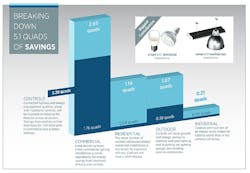DOE says that LED lighting will slash energy usage by 5.1 quads in 2035
The US Department of Energy has issued a biennial research update on the impact of LED-based lighting in general illumination applications and said SSL technology will be responsible for a 75% reduction in 2035.
The US Department of Energy (DOE) has published the 2016 edition of its biennial report entitled "Energy savings forecast of solid-state lighting in general illumination applications." The new report extends the projections on energy savings due to LED use in general illumination through 2035, whereas the prior report covered the period through 2030. Data in the 2016 report is based on a new research model and states that cumulative energy savings due directly to a solid-state lighting (SSL) transition in the US lighting sector will total 62 quads (quadrillion BTUs) between 2015 and 2035 relative to a scenario in which no LED lighting had been installed.
Interested in articles & announcements on LED lighting?
The DOE said the new model is more accurate than prior models in addition to extending the projection period. With more years of LED adoption behind us, the new research is more granular and finely calibrated according to the agency. The aforementioned cumulative savings is said to be equivalent to $630 billion in avoided energy costs.
The prior forecast linked above had projected that in 2030 LEDs would deliver an annual energy savings of 4.5 quads. Now the agency projects that by 2035 the SSL transition will save 5.1 quads. That projection essentially represents a reduction of energy use by 75% — estimated as the total energy used by 45 million US homes today.
The granularity of the new data model has allowed the DOE to pinpoint the applications and usage scenarios where LED lighting will make the biggest impact. Commercial applications will represent 2.65 quads and residential 1.14 quads. Across different applications the use of autonomous and programmatic controls will account for 2.28 quads in savings.
The granularity also extends to types of lighting installed. Linear and low/high-bay fixtures, the mainstay of commercial lighting, will be product areas that deliver the greatest benefit. The residential transition to LED A-lamps, and to a lesser extent directional lamps, will deliver the second largest benefit and ultimately the lowest projected actual energy use in 2035 of 0.08 quads.
The DOE said its new model will also be used in many of the agency's other research reports. For example, the model will be utilized in the next "Adoption of LEDs in common lighting applications" report. The next version of that biennial report will be due out next summer.
You can read the full new energy-savings report directly on the DOE website. Moreover, we've covered a number of other DOE reports on specific markets and applications recently. For instance, back in July we covered reports on LED downlights and on OLED lighting. Later in the summer, we covered a report focused on the market for LED-based tubes intended to replace linear fluorescent tubes.

Maury Wright | Editor in Chief
Maury Wright is an electronics engineer turned technology journalist, who has focused specifically on the LED & Lighting industry for the past decade. Wright first wrote for LEDs Magazine as a contractor in 2010, and took over as Editor-in-Chief in 2012. He has broad experience in technology areas ranging from microprocessors to digital media to wireless networks that he gained over 30 years in the trade press. Wright has experience running global editorial operations, such as during his tenure as worldwide editorial director of EDN Magazine, and has been instrumental in launching publication websites going back to the earliest days of the Internet. Wright has won numerous industry awards, including multiple ASBPE national awards for B2B journalism excellence, and has received finalist recognition for LEDs Magazine in the FOLIO Eddie Awards. He received a BS in electrical engineering from Auburn University.





